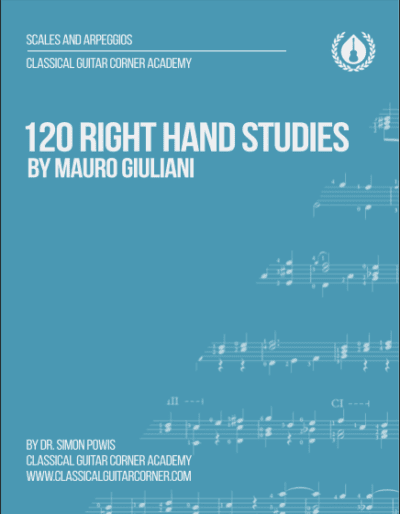
120 Right-Hand Studies
Giuliani’s 120 Right-Hand Studies are a must for all guitar students. They give you a great way to develop a strong and consistent right-hand technique. After almost 200 years, guitarists all over the world use this for technique development.
Italian virtuoso Mauro Giuliani (1781 – 1829) wrote 120 Right-Hand Studies in the early nineteenth century. The fact that they are still widely in use today is a testament to their quality. Using a simple alternation between a C Major chord and a G Dominant Seventh chord, Giuliani has come up with a set of progressive studies. They will help you structure practice, work on specific right-hand techniques, and systematically develop almost any arpeggio pattern that might be encountered in the classical repertory.
Music has changed over the years and modern repertoire has made new demands on the right hand. However, Giuliani’s 120 Right-Hand Studies remain one of the most effective tools to develop a solid right-hand technique. Using them will help you create a firm foundation for any repertoire.
As with scales, the teacher and student can build upon these right-hand studies to refine musical aspects. Work together on chord voicing, articulation, tone control, and dynamics. Challenge yourself to compound your technical workout with a musical agenda and these simple studies will provide another level of musical development.
Practice technique
When I first encountered these studies, I was stuck on the first one for quite some time. Seemingly simple, the first study requires you to balance the voices in your right hand. Doing this well allows you to make the chord progressions balanced and smooth. Aim to bring out the various voices and you will be on the path to developing the refined right-hand control needed to play the majority of classical guitar music.
Don’t let Giuliani’s 120 studies overwhelm you by trying to tackle them all in one sitting, or even several sittings. Instead, take small groups of them and work diligently, being critical of your sound, articulation, and shifting. If you feel comfortable with a particular study, then add some challenges to it. You can alter the rhythm, add dynamics, vary the tone quality, and more. If you find that some provide difficulty, make a note of them and single them out for slow, methodical practice. With time and patience you will be able to conquer each study and your technique will be the better for it. We all have different skills and challenges, so don’t be down on yourself if you struggle with some. Rather, be excited that you have isolated a problem and now have the opportunity to improve!
The First Study
The first study is a deceptive one. Being the first of many I guess you might think it is going to be the most basic. Indeed, it does look basic, however, the first of Giuliani’s studies actually taps into one of the more sophisticated aspects of the classical guitar. Voicing.
The first study has the thumb and two other fingers working together to play a single chord. The difficulty in this seemingly simple study is that you need to be able to control the sound and volume of each voice. Each digit on our right hand is different, and each nail is unique. Given this variation we have to learn how to make a sound with each finger that is controlled, consistent and will match the other fingers being played, both in dynamics and tone.
Three challenges for the first study:
- Play all notes at exactly the same time. It is often tempting to break the notes apart, just a little, in fact our hands are very good at making this effect. It is often called “rolling” a chord or playing a “broken” chord. This effect can eventually get a bit dated, so it is important to practice playing the notes together.
- Play through the study three times (with the repeats) and each time bring out (play louder) a different voice. On the first run bring out the top notes. On the second run bring out the bass, and finally bring out the inner voice. This is challenging!
- Now that you have worked on controlling the individual voices, see if you can play a perfectly balanced chord. There will be a hierarchy in this chord and the hierarchy goes like this: (in order of importance)
- Treble
- Bass
- Inner voice
So, that’s one down.
For the other 119 studies you will find that some come easily and some present difficulties. Isolate the tricky ones and work on them diligently. As a general guide these are the things you want to be thinking about when you are working on the studies:
Sound – both quality and consistency. I know that sounds good, but could it be better?
Consistency – Getting one note sounding good isn’t enough, make sure you can control all the notes all of the time.
Balance – Like I was saying try an get your right hand fingers to have controlled dynamics. If one finger is especially loud or soft, see if you can bring it into line.
Adding exercises
Here is a list of ideas for you to add more aspects to the 120 studies:
- Dynamics (p, mf, f, ff, crescendo, decrescendo)
Articulation (staccato, legato, accents)
Tone control (tasto, pont, and variations in between!)
Tempi (adagio to presto, accelerando and decelerando)
Expression (sadly, joyfully, nostalgically, serenely)
Voicing (bring out different lines in the studies, bass, middle and upper voices)
